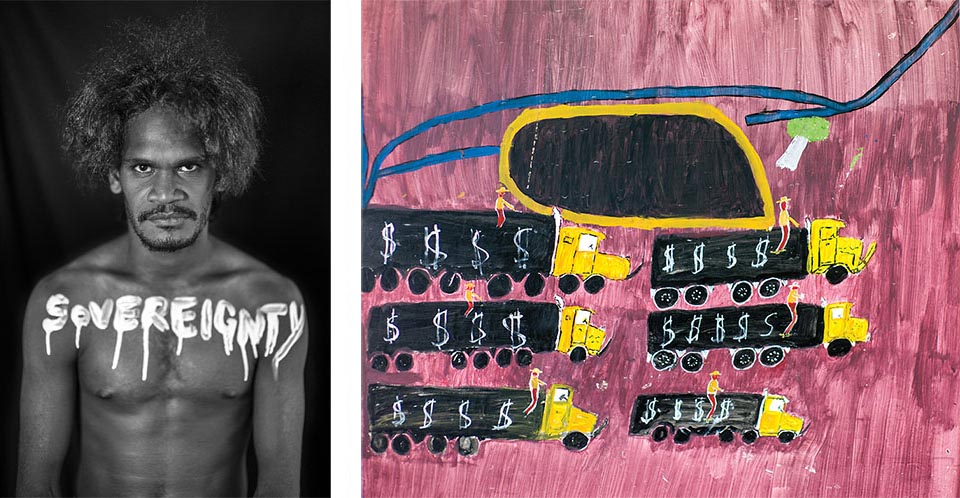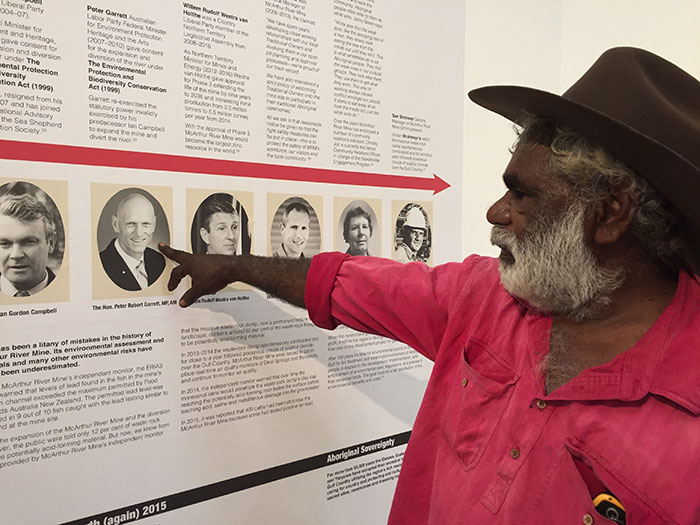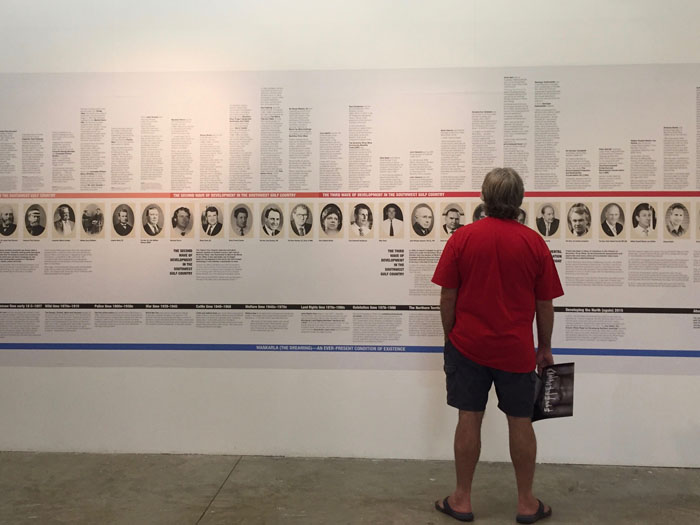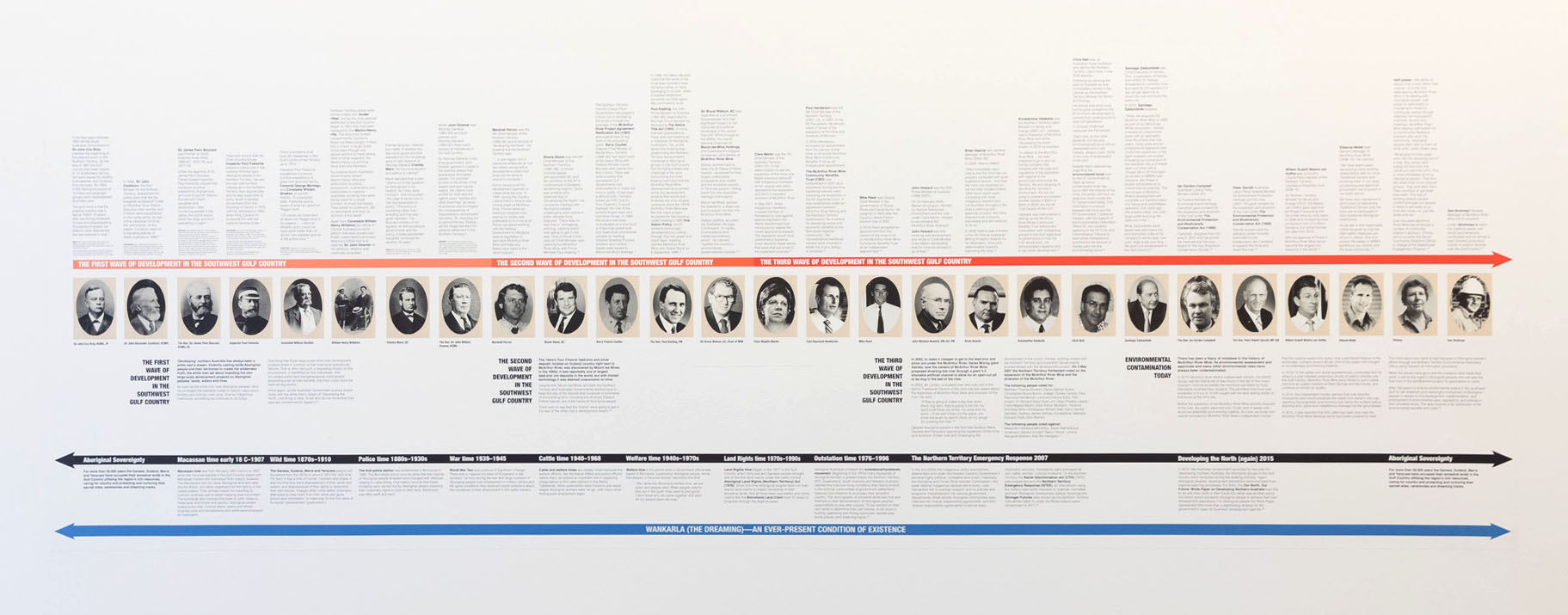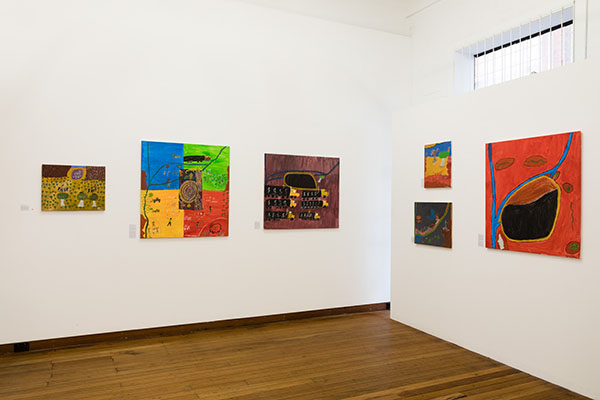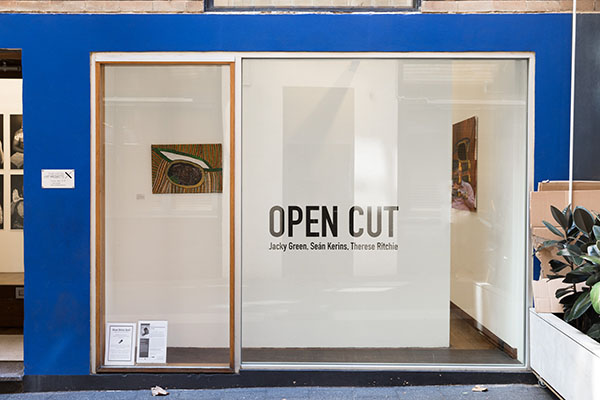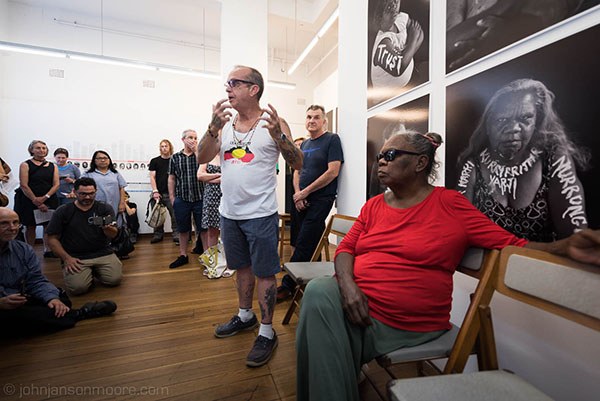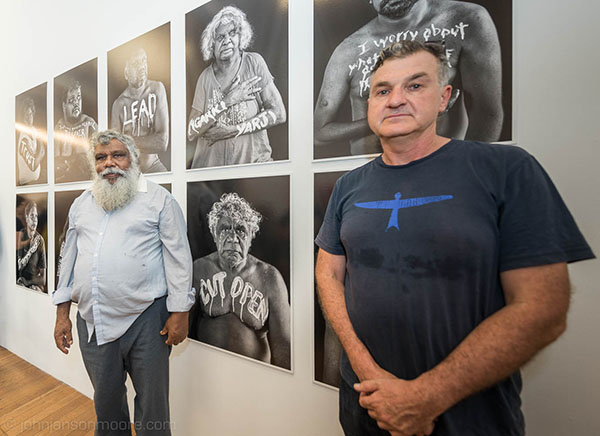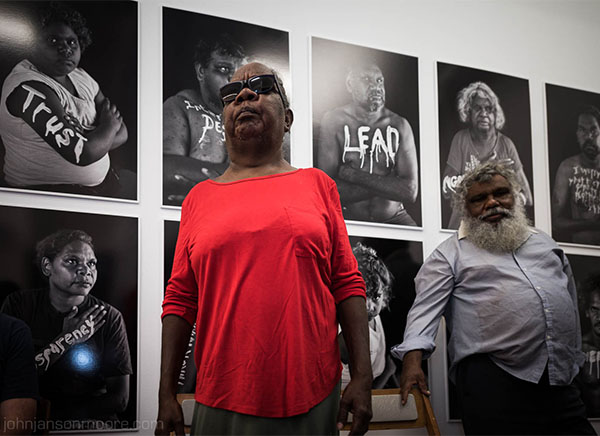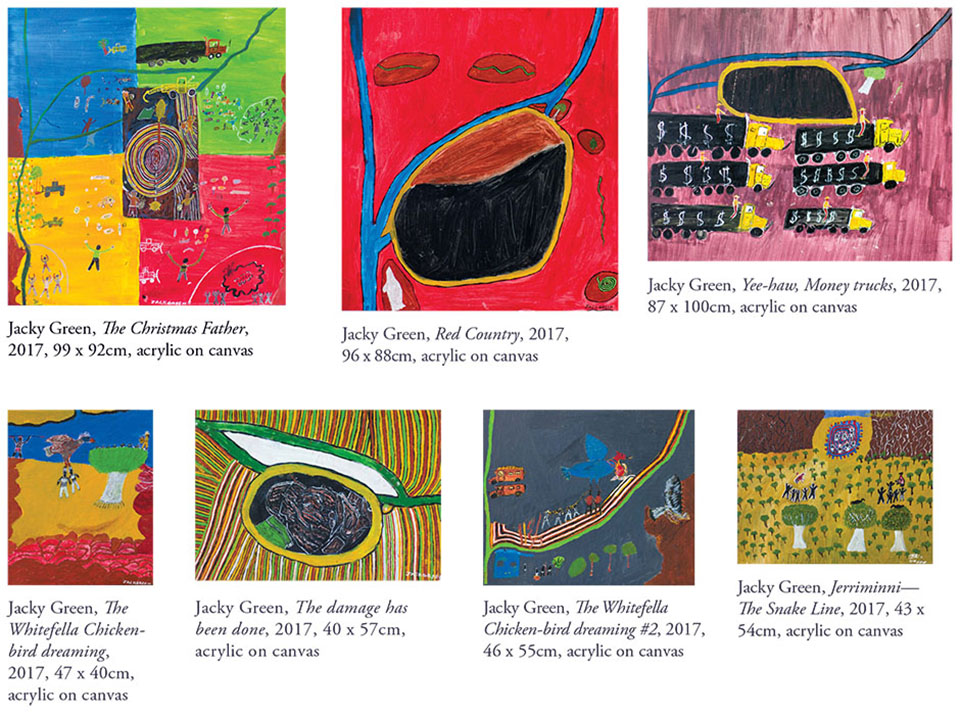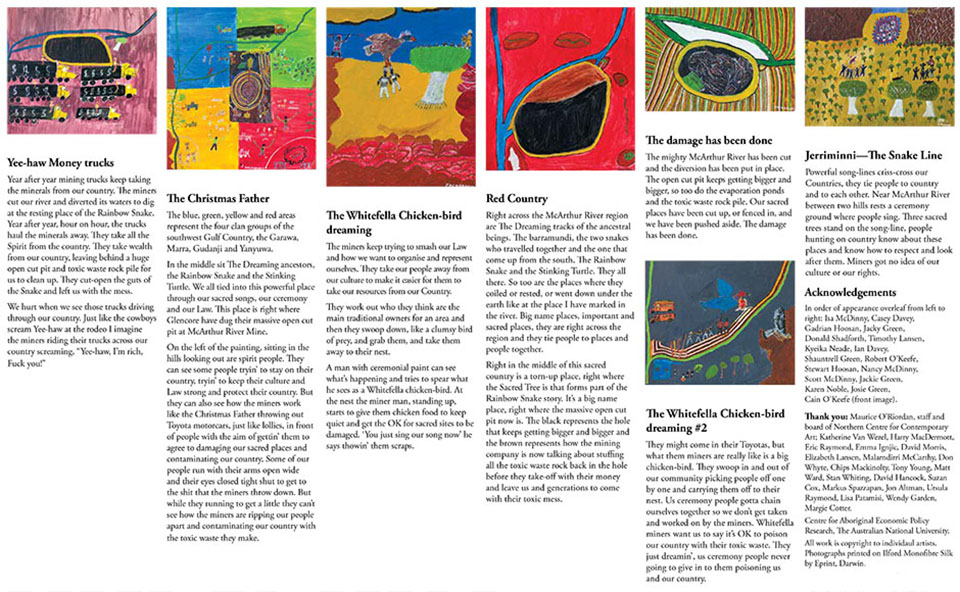
Open Cut: Jacky Green, Sean Kerins, Therese Ritchie — 24 February to 31 March 2018
Open Cut: Jacky Green, Sean Kerins, Therese Ritchie
Opening Saturday 24 February with a Floor talk at 2.30pm
Exhibition 24 February to 31 March 2018
About
The exhibition Open Cut brought to life the power imbalance between mining companies and Aboriginal peoples on whose Country minerals and natural gas are extracted while they themselves remain in poverty. The installation combined stories, photography, painting and a timeline history graphic of the south-west Gulf of Carpentaria, gathered through multiple consultations in 2017.
Through these means the artists aimed to present the voices and authority of Garawa, Gudanji, Marra and Yanyuwa peoples from the Borroloola area of in the south-west Gulf region of the Northern Territory—land owners and managers whose voices are ignored, cast aside or silenced. Mining developments continue to harm their lives, contaminate their food and destroy their ancestral Country.
From the first wave of ‘developing the north’ in the 1870s through guns, poison and intimidation, to the development of an open-cut lead and zinc mine beside the McArthur River, it has been the same story.
Artists Jack Green (Garrwa, Gulf of Carpentaria and Visiting Indigenous Fellow at the Australian National University), Therese Ritchie (Darwin) and Sean Kerins (CAEPR Fellow at ANU) created a powerful installation and platform to reinstate political agency. The Open Cut collaboration inspires us to look beyond the jingoistic slogan ‘developing the North’ to truly view mines, waste dumps, dams and fracking for what they are. The artists and owners propose a future working on carbon abatement, Indigenous Protected Areas and caring for Country.
Jack Green is renowned for his punchy paintings that carefully document the dispossession of Indigenous owners by Australia’s ’good to go’ world of government agreement and the socially corrosive hard corruption of money. In 2015, he won the Australian Conservation Foundation’s Award for his sustained personal effort to speak out and to question government legislation affecting the region. Jack Green and Sean Kerins have had a long-standing collaboration on Caring for Country projects.
For Therese Ritchie’s dramatic black and white portrait photographs, her subjects carefully choose words such as ‘My Country’, ‘Cut open’ and ‘Sovereignty’ to paint boldly on their bare chests and arms—literally embodying the cultural and social impacts that exploitative mining has had on their very beings, families and communities. Bitterly, many of those pictured are the same people who spoke out against a zinc mine in 1981 to make the legendary film Two Laws. Since then they have been betrayed by McArthur River Mine and a parade of federal and Northern Territory governments. Ritchie’s installation brought together generations of anguish and anger.
In video and at the opening of the exhibition, artist colleagues Stewart Hoosan and Nancy McDinny explained ‘why they don’t do “Dreamtime” paintings’, instead referring to the project’s collaborative timeline to expose how over the past 140 years, European development projects have continuously resulted in the killing of their people and the poisoning of Country—and ask why their Country carries the name of the man who masterminded the massacre of their ancestors.
Open Cut joined the Flow of Voices set of exhibitions at The Cross Art Projects to deliver a momentous body of contemporary works to archive, critique and expose settler colonialism, mining and social justice in the Gulf of Carpentaria in the Northern Territory of Australia.
Background
In 2006 McArthur River Mine, owned by Glencore / Swiss giant Xtrata, expanded from an underground to an open cut operation. The government approved the diversion of the major tropical McArthur River by 5.5 Km, causing deep wounds to significant sacred sites. Now, over ten years down the track and despite multiple complaints, McArthur River Mine has an enormous toxic waste problem with no solution in sight.
Despite the travesty, late last year Glencore began lobbying to expand and to keep producing lead and zinc for another 30 years. The respected Australia Institute responded by saying the company’s Environmental Impact Statement was “laughable” and questioned its economic arguments for expansion. (ABC News, 11 September 2017. See: http://www.abc.net.au/news/2017-09-11/mcarthur-river-mine-expansion-economic-arguments-questioned/8891316).
The Australia Institute report points out Glencore has not paid company tax. (The only recorded tax payment to the ATO was when zinc prices boomed.) Nor does Glencore pay royalties to the Northern Territory government. Of jobs, over 95% workers are fly-in, fly-out. Glencore claims to pay a small ‘Community Benefit’, but the area’s vital health, education services are funded almost entirely by the government.
The Australia Institute concludes that from an economic perspective, the best approach is to close the mine and ensure Glencore pays for rehabilitation.
Image right: Jacky Green, Yee-haw, Money trucks, 2017, 87 x 100cm, acrylic on canvas. Courtesy the artist
Image left: Therese Ritchie, Cain O’Keefe, 2017, digital print on Ilford Monofibre Silk, 84 x 56cm. Courtesy the artist
Yee-haw Money trucks, Jacky Green Artist Statement:
Year after year mining trucks keep taking the minerals from our country. The miners cut our river and diverted its waters to dig at the resting place of the Rainbow Snake. Year after year, hour on hour, the trucks haul the minerals away. They take all the Spirit from the country. They take wealth from our country, leaving behind a huge open cut pit and toxic waste rock pile for us to clean up. They cut-open the guts of the Snake and left us with the mess. We hurt when we see those trucks driving through our country. Just like the cowboys scream Yee-haw at the rodeo I imagine the miners riding their trucks across our country screaming, “Yee-haw, I’m rich, Fuck you!”
Jack Green viewing timeline by Sean Kerins and Therese Ritchie with assistance by Jacky Green.
Jack Green, Sean Kerins, Therese Ritchie, installation of timeline.
Jack Green, Sean Kerins, Therese Ritchie, installation of timeline.
Stewart Hoosan (Garawa) reflects on how, over the past 140 years, European development projects have resulted in the killing of his people and the poisoning of Country.
Nancy McDinny (Garawa) asks why her Country carries the name of the man who masterminded the massacre of her ancestors.
Open Cut installation shot.
Open Cut installation shot.
Open Cut installation shot.
Open Cut Exhibition Opening. Photography by John Janson-Moore http://www.johnjansonmoore.com/
Open Cut Exhibition Opening. Photography by John Janson-Moore
Open Cut Exhibition Opening. Photography by John Janson-Moore
Open Cut Exhibition Opening. Photography by John Janson-Moore
Open Cut Links
Open Cut on Facebook – https://www.facebook.com/OpenCut
Open Cut on Twitter – https://twitter.com/OpenCut
Open Cut on Instagram – https://www.instagram.com/opencut
About the Artists
Jack Wongili Green: is a Garrwa man, born in 1953 and educated on country before working as a stockman. Later, Jack worked for the Northern Land Council and is a director of the Carpenteria Land Council. Jack has spent over 30 years fighting for the protection of his country and its sacred sites and founded the Garawa Rangers and Waanya/Garawa Rangers and continues this work today, for which he won the 2015 Peter Rawlinson Conservation Award. He began to paint in 2008 to get his voice heard, to show others what is happening to his country and people. His work is represented in the collection of the Australian National University and he has been a finalist in the Telstra National Aboriginal and Torres Strait Islander Art Award in Darwin (2016).
Sean Kerins: is a research fellow at Centre for Aboriginal Economic Policy Research at the Australian National University. He has worked with Indigenous peoples and communities for the last 25 years on cultural and resource management issues. He has collaborated with senior Garrwa man Jack Green on a series of important articles, notably in People on Country, Vital Landscapes, Indigenous Futures (edited by Jon Altman and Seán Kerins, 2012).
Therese Ritchie: is a resident Darwin artist, photographer and graphic artist whose experiences and insight into the political and social life of the Northern Territory continue to inspire her contribution to Australian contemporary art. Therese Ritchie artist’s website at http://www.thereseritchie.com/art.com/home.html
Exhibition History
Open Cut was first shown at NCCA in Darwin (July 2017). Lismore Art Gallery (Curator Djon Mundine, November 2017), The Cross Art Projects (February to March 2018), Counihan Gallery in Brunswick, Melbourne (June 2018, curators Jo Holder and Djon Mudine). Thanks to NCCA, Lismore Art Gallery and Counihan Gallery.
Open Cut joins the previous Flow of Voices set of exhibitions at The Cross Art Projects on contemporary art, settler colonialism and mining and social justice in the Gulf of Carpentaria in the Northern Territory of Australia. In the first and second iterations Jack Green, Stewart Hoosan and Nancy McDinny, compared the brutality of the colonial frontier with ongoing settler colonialism and large-scale developments such as mining. Without proper respect for people and country, racial hierarchies and imperialist attitudes persist. In the process the artists’ voices have been aggressively censored and an international art publication threatened with a “take down” order. (August 2017.)
Flow of Voices 1 – https://www.crossart.com.au/exhibition-archive/art-mining-flow-of-voices-1-jacky-green-11-april-to-17-may-2014
Flow of Voices 2 – https://www.crossart.com.au/exhibition-archive/frontier-history-flow-of-voices-2-jacky-green-stewart-hoosan-and-nancy-mcdinny-22-may-to-5-july-2014
Flow of Voices 3 – https://www.crossart.com.au/exhibition-archive/social-licence-flow-of-voices-3-jack-green-stuart-hoosan-nancy-mcdinny-with-miriam-charlie-29-october-to-26-november-2016
Artist Interviews (video):
Harry Lansen, ‘Song for the Rainbow Serpent’ at: http://www.youtube.com/watch?v=kgwaxalFs3g
Nancy McDinny, We Paint We Belong https://vimeo.com/103477439
Stewart Hoosan, Elders Protecting Country https://vimeo.com/168735886
Action: Our Land Is Our Life https://vimeo.com/166492977
Miriam Charlie, ‘My Country No Home’: https://vimeo.com/158590440
Miriam Charlie, ‘Gulf to Gallery’ – http://www.abc.net.au/news/2016-05-26/indigenous-photographer-miriam-charlie-opens-borroloola-exhibit/7444802
Borroloola mob: Mining on Traditional Lands — Film and video documents
1981: Two Laws, film made in 1981 (Directed by Carolyn Strachan/Alessandro Cavadini) is a history of the Borroloola Aboriginal Community and shows the start of mining on tribal land: http://www.youtube.com/watch?v=UuUW-F8c4OY; 2007: Sacred Land Film Project: In August 2007 they travelled to the Supreme Court hearing on the legality of the McArthur River mine expansion. http://www.youtube.com/watch?v=HonesSabEi; 2014: Dirty Business: How Mining Made Australia, film directed by Jacob Hickey and Sara Tiefenbrun for Renegade Films. SBS TV, 2014. Borroloola mob’s Call to Action 2 min clip and Protecting Country from Fracking, a 20 min film. Harry Lansen, ‘Song for the Rainbow Serpent’ at: http://www.youtube.com/watch?v=kgwaxalFs3g
Borroloola mob / Gulf Country References
John Bradley with Yanyuwa families, Singing Saltwater Country. Journey to the Songlines of Carpenteria (Alen & Unwin, 2010)
Tony Roberts, Frontier Justice, A History of the Gulf Country to 1900 (UQP, 2005). > Download pdf
Tony Roberts, ‘The Brutal Truth. What happened in the Gulf Country’, The Monthly, 2009. > http://www.themonthly.com.au/issue/2009/november/1330478364/tony-roberts/brutal-truth
Gulf Country Songbook: The Gulf Country Songbook, published by Waralungku Art Centre (December, 2016) showcases some of the many songs composed in Yanyuwa, Marra, Garrwa and Gudanji languages in the last 100 years. There are songs of land rights claims, of the maranja – ‘dugong hunters of excellence’, of paddling a canoe on the sea at night, of boundary riders on a pastoral station, and Ancestral Beings journeying across country… The Gulf Country Songbook includes Yanyuwa, Marra, Garrwa and Gudanji words of the songs and English translations / interpretations. Contact Waralangku Art for the CD (also QR codes) and a DVD of short documentaries.
Articles and Reviews
Jacky Green, ‘Flow of Voices’, Arena Magazine, 2012, No. 124. > Download pdf
Jack Green, Biography and Statement on Work, 2014. > Download pdf
Gina Fairley on Jacky Green’s Flow of Voices for Arts Hub, week of 21 April 2014. > Download as pdf
Seán Kerins, ‘Challenging Conspiracies of Silence with Art’, Art Monthly, Summer 2013/14. > Download pdf
Seán Kerins and Jacky Green, ‘Indigenous country in the southwest Gulf of Carpentaria: Territories of difference or indifference?’ In Jon Altman ed., Engaging Indigenous Economies, 2016. > Download as pdf
Pippa Milne, CCP Declares: On the Social Contract, exhibition catalogue, (with Miriam Charlie) Centre for Contemporary Photography, Melbourne, 2016. > Download as pdf
Amy Quire, ‘Jack Green, Beyond Dot Paintings’, illustrated feature, New Matilda print and on line, 25 Feb 2015. https://newmatilda.com/2015/02/25/beyond-dot-paintings
Indigenous Australian Corporation Accused of Censoring Aboriginal Artists by Crystal Wu > Download as pdf
Glencore mine’s ‘deal’ with Indigenous owners called into question, documents reveal – https://www.theguardian.com/global/2017/jun/16/glencore-mines-deal-with-indigenous-owners-called-into-question-documents-reveal
Borroloola mob
Films: Two Laws, film made in 1981 (Directed by Carolyn Strachan/Alessandro Cavadini) is a history of the Borroloola Aboriginal Community and shows the start of mining on tribal land: http://www.youtube.com/watch?v=UuUW-F8c4OY
Sacred Land Film Project: In August 2007 they travelled to the Supreme Court hearing on the legality of the McArthur River mine expansion. http://www.youtube.com/watch?v=HonesSabEiE
Borroloola mob’s Call to Action 2 min clip and Protecting Country from Fracking, a 20 min film, can be accessed here.
Harry Lansen, ‘Song for the Rainbow Serpent’ at: http://www.youtube.com/watch?v=kgwaxalFs3g
Facebook page Don’t Frack the Territory has local content on the campaign featuring Gulf region mob.
About Mining and Natural Gas Extraction in the Borroloola region
Mining and Natural Gas Extraction in the Gulf region: McArthur River Mine operated by Glencore Xtrata (located 65 km south-west of Borroloola, 120 km south of the Bing Bong loading facility and 900 km southeast of Darwin), is one of the world’s biggest open cut zinc mines. Ten years down the track and despite multiple complaints, there is an enormous toxic waste problem: a pile of toxic waste the size of 250 Melbourne Cricket Grounds. (14 February 2016, ABC Radio National, Background Briefing by Jane Bardon.) Natural Gas Is the new threat. The NT government’s mapping shows 85% of the NT is under exploration license or application for exploration license for oil and gas. Permits to drill cover more than 90% of the region. The new NT Chief Minister Michael Gunner said, ‘There is a moratorium on hydraulic fracturing, or fracking … but general exploration activities are all fine’. (14 September 2016, ABC News.) The artists have fundraised to support the NT Environment Defenders Office.
About Natural Gas mining and fracking in Northern Territory
The NT Government’s own mapping shows 85% of the NT is under exploration licence or application for exploration licence for oil and gas. Permits to drill now cover more than 90% of the region (see map attached). This online interactive map allows users to see areas in the Territory already approved for oil and gas exploration. The light orange areas are under application by oil and gas companies that want the rights to frack, while darker orange shading means approval has already been given. Residents and Traditional Owners from the Gulf region have been a leading voice in the campaign for protection of land, water and communities from fracking. They have been taking part in protests, speaking at local and national events, taking part in the Territory Frack-Free Alliance to help coordinate the campaign from regional and remote areas and even producing artwork highlighting the risks of fracking to country and culture. Both the Nawimbi and Garawa Land Trusts have voted unanimously to veto shale gas exploration on their land trusts covering the townships of Borroloola and Robinson River.
Bibliography
2014: Dirty Business: How Mining Made Australia, film directed by Jacob Hickey and Sara Tiefenbrun for Renegade Films. (Shown on SBS TV, 2014.)
For general information on shale gas fracking: www.dontfracktheterritory.org and Lock the Gate at http://www.lockthegate.org.au/
Mining in Gulf Region
Glencore mining (McArthur River Mine) from 2011:
15 Mar 2011: Jane Bardon, ‘Mining giant accused of “rude” behaviour’.
7 Dec 2011: ABC Rural, Liz Trevaskis, ‘Environmental Concerns for McArthur River Mine’.
4 Jun 2013: ABC News, ‘McArthur River mine expansion plan approved by the Northern Territory Government’, By Jano Gibson. The phase three development will more than double the amount of zinc and lead produced at the site, making it the largest zinc resource in the world. http://www.abc.net.au/news/2013-06-04/mcarthur-river-mine-expansion-plan-approved-phase-three/4732154
In 2014 in response to a waste dump fire, Glencore was ordered to submit a new Environmental Impact Statement to be allowed to continue expanding. It expects to produce that report next year.
27 July 2014: ABC News, ‘McArthur River mine’s burning waste rock pile sparks health, environmental concerns among Gulf of Carpentaria Aboriginal groups’ by Jane Bardon. http://www.abc.net.au/news/2014-07-27/mcarthur-river-mine-gulf-of-carpentaria-anger-smoke-plume/5625484
3 September 3, 2015, Cairns Post: ‘Borroloola residents betrayed by Glencore’: report by Neda Vanovac, AAP http://www.cairnspost.com.au/news/breaking-news/locals-petition-for-glencore-mine-closure/news-story/ccc75fa6f86762c72232a6be14c5d26a
14 February 2016, ABC Radio National: ‘Glencore’s acid test’ by Jane Bardon, Background Briefing. The McArthur River mine in the NT is one of the biggest open cut zinc mines in the world. Ten years down the track it’s been discovered there’s an enormous toxic waste problem, with no current solution. An investigation into the scramble by mining giant Glencore and authorities to work out how to manage a pile of toxic waste the size of 250 Melbourne Cricket Grounds. http://www.abc.net.au/radionational/programs/backgroundbriefing/glencores-acid-test/7162422
21 August 2016, ABC News Radio: ‘McArthur River Mine expansion approval process should halt for inquiry’: report by Jane Bardon http://www.abc.net.au/news/2016-08-21/mcarthur-river-mine-expansion-full-inquiry-needed-report/7769210
14 September 2016, ABC News Radio: ‘Fracking moratorium takes effect in Northern Territory, Chief Minister Michael Gunner says’: report by Avani Dias. Michael Gunner announced the move at an oil and gas summit in Darwin. He said, “The moratorium includes exploration – you cannot hydraulically frack unconventional gas reserves for exploration – but general exploration activities are all fine” ‘. http://www.abc.net.au/news/2016-09-14/nt-government-introduces-fracking-moratorium/7843502
28 October 2016, ABC News: ‘McArthur River Mine to defend secrecy of bond alone as NT Government steps back’ by Sara Everingham. In what is believed to be the first proceeding of its kind, the NT Environmental Defenders Office and Borroloola resident Jack Green have appealed against the Northern Territory Government’s decision to withhold the bond figure from documents released through Freedom of Information. http://www.abc.net.au/news/2016-10-28/mcarthur-river-mine-to-defend-secrecy-of-bond-alone/7974000
29 November 2016, ABC News, ‘McArthur River Mine workers break silence with allegations of serious injuries from toxic smoke’, by Jane Bardon: Former fly-in-fly-out workers have told the ABC they have serious injuries after breathing in toxic smoke from burning rock on one of the world’s biggest zinc and lead mines, and that owner Glencore has not offered compensation or assistance. They blame sulphur dioxide plumes from the mine. A respiratory specialist says it is hard to prove the mine gases caused the health problems. They are also alleging that staff at the McArthur River Mine in the Northern Territory were ordered to cover up the extent of a fire on the huge man-made mountain where the company is dumping its waste rock. For the first time Glencore has publicly confirmed to the ABC that it is aware that one of its workers has alleged they have been injured. The dump has been burning since at least 2013, sending out a huge plume of sulphur dioxide smoke. Glencore has responded by saying the mine complies with the NT Workers’ Rehabilitation and Compensation Act.
Mining on Traditional Land—Xtrata Stage 1 Approvals process (2007-2010)
Stage 1 Approvals process: ‘Xstrata will get approval for controversial McArthur River mine expansion’, International Business Times, 22 Jan 2009. Peter Ker, ‘Garrett backs controversial mine’, The Age, 23 Jan 2009. Independent Monitor, ‘McArthur River Mine Community Report’, Environmental Earth Sciences, 2011. Paddy Manning, ‘Xstrata digs deep for prized zinc deposits’, Sydney Morning Herald, 11 Aug 2012. Australian Broadcasting Commission (ABC) TV & Online: Melinda James, ‘McArthur River Mine’ (transcript), Stateline, 6 Oct 2006. Melinda James, ‘McArthur River Mine’ (transcript), Stateline, 4 May 2007. ABC Online News Reports (chronological): Emma Masters, ‘Damning report card for McArthur River Mine’, 12 Nov 2009.
Download
Map: McArthur River system > Download pdf
Natural Gas mining and fracking:
The NT Government’s own mapping shows 85% of the NT is under exploration licence or application for exploration licence for oil and gas. Permits to drill now cover more than 90% of the region (see map attached). This online interactive map allows users to see areas in the Territory already approved for oil and gas exploration. The light orange areas are under application by oil and gas companies that want the rights to frack, while darker orange shading means approval has already been given.
Residents and Traditional Owners from the Gulf region have been a leading voice in the campaign for protection of land, water and communities from fracking. They have been taking part in protests, speaking at local and national events, taking part in the Territory Frack-Free Alliance to help coordinate the campaign from regional and remote areas and even producing artwork highlighting the risks of fracking to country and culture. Both the Nawimbi and Garawa Land Trusts have voted unanimously to veto shale gas exploration on their land trusts covering the townships of Borroloola and Robinson River.
For general information on shale gas fracking: https://www.protectcountrynt.org.au/ and Lock the Gate at www.lockthegate.org.au/

